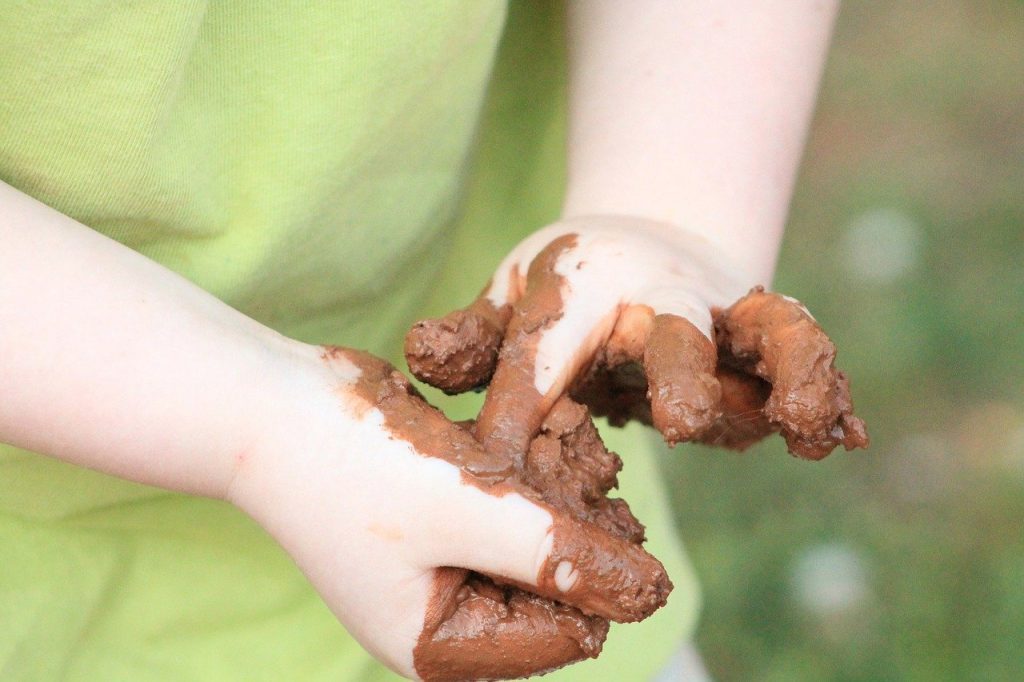
Table Of Contents
Know What To Expect
Don’t be caught unprepared–approach mud play with your eyes wide open. Some forethought about things kids will do with mud during mud play simplifies supporting and managing the activity.
Many of the mud-based activities outlined below get labeled as “bad” behavior, are shut down as soon as they happen, and are often used as excuses for not offering mud play. This is sad, since all these activities are learning-rich experiences.
Here, in no particular order, are 10 things you should be prepared for kids to do with mud:
Tasting It
The younger the children at play, the more likely mud will go in the mouth, but older kids do this as well. We humans are wired to use our senses to explore the world. Two-year-old Lizbet thinks, “This stuff looks like chocolate pudding, does it taste like it too? Let’s find out!” and into the mouth it goes.
But don’t worry. Your mud supply is safe and so are the kids as long as you’re thoughtful about sourcing your mud. It turns out, mud tastes nothing like chocolate pudding. A small taste or two is enough for most kids to gather the information they need and move past their interest in tasting it. It is highly unlikely that they will find it irresistible and consume it all. Remember, tasting does not mean eating. Even if Lizbet fills her mouth with the stuff, she’s unlikely to swallow much at all.
Squishing It
Squeezing sloppy handfuls of mud until it oozes through their fingers is another thing you can expect kids to do with mud. This small muscle and tactile activity is another way kids–especially younger ones–tend to explore mud. Squishing is a way to get to know the physical properties of the material.
Throwing It
Throwing is another one of the things kids will do with mud. Once Edwin has tasted it and squished it, chances are he’ll toss a handful of it onto the ground, into the air, or across the playground.
This is a STEM-rich activity. The chance to observe objects in motion and how they interact with their surroundings. Throwing mud is an opportunity to learn about Mass, Motion, Gravity, cause-and-effect relationships, social interactions, and more.
Smashing It
Smashing mud—with a hand, foot, stick, shovel, potato masher, or cookie sheet—is another thing kids will do with mud. This is an opportunity to see how materials react and interact. It’s also an opportunity to hone physical skills like balance, hand-eye coordination, grip pressure, and limb control.

Shaping It
This usually happens with thicker mud, since it has more structural integrity. Clover works for 45 minutes shaping mud and says, “Look! I made my cat!”, her classmate Hadleigh spends the same amount of time sculpting something she claims is “Grandma’s house”, and Reece works even longer constructing what he claims is “baby baby Yoda”. You ask a few open-ended questions and comment on how long they worked on their creations, but see three identical blobs of mud. But that doesn’t matter, like the rest of the items on this list, it’s the process that counts. Early learning lives in the doing of things.
Stirring It
Whether with a twig in an old ceramic ramekin or with a kayak paddle in a stock tank, stirring is another one of the things kids will do with mud. This is an opportunity to build muscle strength and control. Watching the materials being stirred mix is also a STEM activity–a chance to notice the properties and interactions of the varying materials.
Scooping It
Scooping, scooping, it’s such a thrill. Scooping, scooping, yes they will. Sometimes, scooping is an activity in itself. Other times, it is one of the things kids will do with mud that they need to do before they can do the other things kids will do with mud. For example, they have to scoop it into a bucket before they can haul it across the playground, or they have to scoop it onto the ground before they can smash it with their toes.
Drying It
Of all the things kids will do with mud, letting it dry is probably the least messy. Some kids create things from mud—sculptures, pies—that need setting aside until dry. Every mud play area should have a designated drying spaces. Letting mud dry on their skin is another version of mud drying. It’s a bit more inconvenient to support this activity, but it is worth the effort since it is such a rich sensory experience.
Hauling It
Kids will always decide that THIS mud should no longer be HERE and needs to be OVER THERE as soon as possible. Then They’ll decide it requires relocating to a third location. And then that it should go back to where it started. Mud hauling is an opportunity to engage in Heavy Work–an important early learning activity.
Smearing It
They’ll smear it on themselves. They’ll smear it on others. They’ll smear it on the table, the walls, the ground, and even sedentary or slow-moving pets. This may be the messiest of all the messy things kids will do with mud. All this smearing is messy, but it’s also a valuable sensory experience that helps with sensory integration. The tactile experience of smearing mud sends the brain bunches of useful sensory information and strengthens connections between the brain and nervous system.

10 Things Kids Will Do With Mud Wrap-Up
There are surely other things kids will do with mud, this list is in no way comprehensive. That Kid will always come up with something unexpected—and probably extra messy. While not comprehensive, this list does provide a decent look at what to expect during mud play.
These mud activities are also gateways to developing language and social skills, as well as honing self-regulation skills. Engagement with mud includes conversation, collaboration, disagreement, success, and failure. All of these are opportunities for learning and refining valuable skills.
Taking these things kids will do with mud into consideration when preparing for mud play will lead to a richer play experience.
Brought to you by Explorations Early Learning
Contribute content to Playvolution HQ
Browse Trainings
Post Author
Jeff Johnson is an early learning trainer, podcaster, and author who founded Explorations Early Learning, Playvolution HQ, and Play Haven.



Leave a Reply